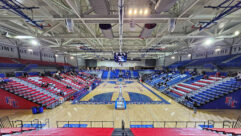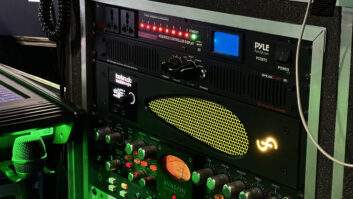BIG CLUBS TUMBLE!
Oct 1, 2001 12:00 PM,
BY DAN DALEY
THE 1990s SEEMED LIKE A LATE-1970s redux. Large dance clubs mushroomed throughout the United States, which was finally catching the fire that Europe’s club scene had long experienced. In celebrity centers such as New York City, the scene hearkened back to the glory days of Studio 54, the Loft and the original Paradise Garage.
The big difference, however, was that this new generation of clubs sounded a lot better. Not only had audio technology advanced in the years since the first disco era faded, but the CD had come along and entrenched the idea of digital sound, raising overall consumer expectations of what music should sound like. A sizable demimonde of partiers were now the ne plus ultra of club-sound critics, and clubs were designed to please their insatiable desire for more bass and louder, clearer music. Sound-system designers and contractors were kept busy outdoing each other as each successive club boasted better and better sound.
TROUBLE IN PARADISE
Today, the club scene has been devastated in several major cities, most notably in New York, where, just since the beginning of 2001, three major icons of clubdom — Tunnel, Limelight and, most recently, Twilo — have been shuttered. The trend is extending itself to other cities. Over the last two years, the liquor licensing board in Chicago has revoked licenses for Karma, Polyester and Art Bar. And, in what some club owners view as the ultimate test case, the United States attorney in New Orleans prosecuted two club owners under the 1986 federal Crack House Statute, which is used against those who maintain a property where they know drugs are sold or used. According to the San Francisco Late Night Coalition, the owners will not serve any time, but there was an injunction prohibiting the use of glow sticks, pacifiers, masks, chill rooms and other items deemed to be paraphernalia — items that have become part of the large club scene.
The forces behind these changes and club closings have been social, political and legal. New York clubs have been under close scrutiny since the first administration of Mayor Rudolph Giulliani in 1992, whose get-tough platform regarding quality-of-life crimes struck a chord with citizens fed up with the glossing over of so-called nuisance crimes, everything from public drinking to boomboxes in subways. And many in the new administration definitively qualified the clubs, and the drug-laced culture that they viewed as adjunct to the clubs, as nuisances.
New York City and the State Liquor Authority were able to close a few clubs over the past several years, particularly those with the most egregious trappings of gangsta culture. Delays in liquor and cabaret licensing took a toll on others. But it took the Federal Drug Enforcement Agency to topple Twilo, the queen of the New York night. A series of highly publicized incidents involving two lethal drug overdoses at the club induced the Feds to take notice. The situation was exacerbated because the club’s management had a “cooling-down room” in the venue to let addled drug users come down from a high; and the club purposely used a private ambulance to transport an overdose victim to the hospital on at least one occasion, failing to notify 911 — a breach of criminal law.
The sense in the club industry is that clubs have been unfairly targeted and that club culture has been politicized to create an easy scapegoat. Many think that the increasing focus on the abuse of the drug ecstasy, which has become synonymous with club culture, and the recreational use of drugs like the super-painkiller OxyContin, have brought the clubs undue scrutiny by association.
There are those in the business, though, who believe that the club industry and the club-goers themselves have to share the blame. High-profile DJ Danny Tenaglia cited instances in which he and another DJ had stopped the music and pleaded with the crowd to stop taking drugs on the dance floor. In at least a few cases, the blatancy of substance abuse, coupled with the crowds and the clamor, forced the city’s hand.
INSTALLED SOUND TAKES A HIT
Regardless of fault, so many major club closings have started to affect the sound-system design and equipment manufacturing businesses. Dan Agne, a partner in the highly regarded sound-system design company Sound Investment Audio, responsible for the audio at high-profile venues around the country, says that the pressure on clubs has caused his company to rethink its strategy and look toward more corporate, commercial and church work. The company has also started a new division, Sound Investment AV, which will do equipment rentals and party events for the corporate market.
The closings are bad enough, Agne says, but add the fact that legal operating restrictions are further slowing the club business, and these concerns and pressures are now scaring off potential investors in new clubs. “People are afraid to spend money on clubs now,” he says. “If you can’t get a 4 a.m. license, you can’t run a club.” The Illinois State Liquor Authority grants two kinds of licenses: open till 2 a.m. or 4 a.m., Sunday through Friday and one hour later on Saturday. Agne continues, “You can’t pay a DJ $12,000 to spin if people get there at midnight and have to leave by two. To put in a comptetive sound system that will bring in the top-name DJs, you need to spend $250,000 at least. But no one wants to make that kind of investment if they’re just going to lose it when the city shuts them down.”
SAFE HARBORS?
Certain cities remain relatively immune from the effects of crackdown campaigns, mainly those in which there is room to keep entertainment districts and residential areas apart. Miami continues to see new clubs opening regularly. In addition to the famous — or notorious — South Beach section, where many clubs are located, the city has recently inaugurated a so-called 24/7 entertainment district that has become the site of several clubs.
Las Vegas is another city whose reputation is based on an amply loud nightlife. Scott Fisher, owner of The Wave, a sound-system design and install company, says he doesn’t feel particularly threatened by club closings elsewhere. “Ninety percent of my business is clubs,” says Fisher, who has done audio installs at several large clubs on the Las Vegas Strip, including Club Utopia, RA (in the Luxor Hotel) and the Kass-Bah at the Aladdin. “If the trend towards cities leaning on clubs expands to other cities, then I’ll have a problem.”
But Fisher believes the issue is geographically dependent, prone to occur where residents and club-goers are forced into close quarters. Las Vegas is not one of those places, he says. But whether it’s in reaction to the pressure on clubs in other urban areas, or just part of club culture’s natural evolution, Fisher says he has noticed a definite trend away from megaclubs and towards toned-down, lounge-type clubs. “The upper-class lounge seems to be gaining popularity over the huge clubs that hold tons of people,” he suggests. He hazards that this could be a survival tactic: “Clubs are always pushing the envelope of the law, so they’re naturally going to be scrutinized. It’s become normal now to see ambulances in front of clubs on weekend nights. So it’s probably in the best interests of the clubs — and the sound business — if they start to tone it down, not draw so much attention, and move towards the lounge model.”
CLUB STYLE EVOLVES
DJs seem to agree. Dina Regine has been spinning in New York City for nearly two decades at virtually every major venue, including Limelight. She says the club scene is gravitating toward the lounge model, in part as a response to the closings of megaclubs, but also because the club culture is at a point where so many varieties of music — trance, house, hip-hop, techno, etc. — are carving out smaller niches. This balkanization of disco is undercutting the role that the megaclub played.
“The clubs aren’t the draw, and they haven’t been for a while,” says Regine. “It’s the promoter that’s the draw. People follow promoters around from club to club, night to night. The club has to be good, and the sound system has to be good. But it’s rare that the club itself is the draw. When it is, it attracts a bridge-and-tunnel crowd, which is not what the hip people want. So they’re moving to small spaces where they can be with people who are like them and who like the same music. And in spaces like that, a huge sound system isn’t as important.”
MANUFACTURER REACTION
The events in New York City and Chicago have been relatively recent, most of the major closings coming within the last year. Thus, the effects of losing several megaclubs, and a possible contraction in that sector in large markets, have yet to be widely felt. Still, there may be some foreshadowing occurring.
“In terms of the type of systems that go into megaclubs, we’re getting the same number of sales inquiries as we have in the past, but we’re not closing as many of them,” notes Jon Sager, director of market development at EAW. However, Sager continues, it’s not clear what to attribute this trend to. “It could be related to the [shutdowns], or it could be related to the overall current economic situation,” he says. “In the end, I’d suspect it’s both.”
More direct is the comment by Danny Abelson, president of Independence Audio Ltd., exclusive U.S. distributor of Turbosound equipment: “It doesn’t take a genius to appreciate that this will have a negative effect on our industry in the long term. If you limit the number of large clubs, it leads to a reduction in sales of large systems.”
Abelson is not ready to concede that the big club market is over, or even winding down. “We’re still quoting large systems out there,” he says, “and the inquiries are steady. But it’s of concern to me that there’s a decreasing number of venues capable of supporting these kinds of large sound systems. There are only a few companies that can credibly put forward a meaningful dance system. And for those companies, the [large dance clubs] have become a larger proportion of revenues over the last five to seven years.”
If the closings make club investors more conservative with their capital, they also have another effect in that a lot of high-end sound equipment winds up on the resale market. Tom Bensen, national sales manager at Group One, in Farmingdale, New York, says that could have an impact on new equipment sales in the short run, but that in the longer term it could actually be beneficial.
“There may wind up being a glut of equipment in the high-end market for a while,” says Bensen. “Some Twilo wannabe is going to buy some of it. But all that means is it could wind up in other, newer, smaller clubs, which are then going to need additional equipment, hopefully from us. As whatever forces knock the top clubs off, the ones below now have an opportunity to move up a notch, and they’ll need more and better sound equipment. I see all this as an opportunity.”
However, the situation’s rapid evolution seems to have made equipment manufacturers more aware of how quickly the trends can change in the club business. The fact that stakes are higher in the wake of the megaclub phenomenon makes that awareness that much more acute.
Some of the best barometers of the fashion zigzags in the club industry are equipment rental and retail companies. One such company, Abracadabra on Long Island, sees the trends change at street level. “It’s up to us to read the situation as early as we can,” says a salesman there who goes only by George. “Do I concentrate on huge JBL boxes, or do I go back to smaller Community speakers for DJs? That’s what I’m watching for.” George says the end of clubdom’s Jurassic period was probably sealed by factors both economic and political. He expects to see more megaclub closings in Manhattan in the near future and as a result is refocusing on more DJ equipment. The logic is that if the 1000 people who were once in one club will now be dispersed among five new smaller venues, there’s less need for large sound equipment but a very real need for four more DJs. “The equipment makers are going to have to gear themselves to the market changes just like we do,” he observes.
Equipment manufacturers are watching, but most believe that diversified product lines will minimize the impact of the loss of megaclubs in major markets. “It’s a shame but not a problem,” says Jeff Mason, marketing manager for EAW’s installation products. “Activity is dropping off in some markets, but it’s picking up in others, like Los Angeles, which historically has never been a big club market. We intend to continue to service the club markts, large and small, and develop new products for it.”
What will happen in the long run to the large dance clubs in the United States? One concern is that municipal anti-drug policies will backfire, driving clubbers further into an already burgeoning basement and rooftop party scene and, ironically, putting potential overdose victims even further from official emergency response. Megaclubs, in a somewhat tamer form, may come to be viewed as the best option to help keep a lid on drugs.
Clubs will remain a source of sales for equipment makers, but, at least in the short run in a few key cities, the party’s over.
Dan Daley is a journalist covering the global media and entertainment industries, and an author, most recently of Nashville’s Unwritten Rules: Inside The Business of Country Music (Overlook Press). He splits his time between New York, Miami and Nashville.
LAST CALLS
The list of cities that are closing or restricting major dance clubs is long and growing. Among the casualties:
Art Bar, Chicago
Club DV8, San Francisco
Club La Vela, Panama City Beach, FL
Club Oasis/VSF, San Francisco
Karma, Chicago
Limelight, New York City
Polyester, Chicago
Tunnel, New York City
Twilo, New York City










